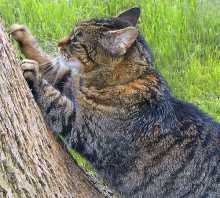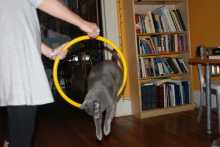Food for Finicky Eaters
Cat Book Roundup
Why Do Cats Always Land on Their Feet?
This book unravels the mysterious ways of cats, which is probably about as effective as trying to understand a woman, but it does give you insights into why cats do some of the crazy things they do. Rated 4.5 stars on Amazon, it is a humorous take on some of the oddest cat behavior.
Chicken Soup for the Cat Lover's Soul
If you are looking for heartwarming, Chicken Soup is the perfect read. Filled with anecdotes and stories about cats, it will make you love cats even more than you already do, according to one reviewer. Achieving a perfect 5-star rating on Amazon, this is a great gift for a cat lover, or a treat for yourself.
The Big Book of Cats
The perfect coffee table collection, The Big Book of Cats features more than 200 black and white photos of cats, accompanied by writings from celebrated authors and personal stories and anecdotes.
Whether you are looking for a gift for a cat lover or a way to celebrate the felines you hold dear, these books about cats are sure to do the trick.
Hairless Cats in Cold Climates
Some might argue that cats will be unhappy if they are locked indoors all the time, and I certainly have never kept a cat solely indoors, so what happens if you have a hairless cat that also likes to venture outdoors?
I know there are sweaters for cats, but if you think of us hairless humans and how we dress to go outside in the winter, a single sweater seems grossly inadequate for keeping those poor kitties warm. I can’t imagine the hassle of putting boots (if it could even be done) and other winter gear on a cat, but I can’t imagine sending them outdoors to freeze in the winter, either.
I suppose a cat is able to make its own decisions – if it wants to go outside badly enough to brave the cold in just a sweater, it is probably capable of deciding to do just that. They are certainly smart enough to know when they are cold and ready to come in, but what if you aren’t there to open the door?
What do you think? Can a hairless cat go outside in the winter? How much clothing would you put on it?
Simon's Cat: Short Diversions for Cat Lovers
Simon's Cat is by a cartoonist named -- you guessed it -- Simon. Watching his cartoons, there can be no doubt that they are truly based on at least one cat. Any cat owner (and lover) will recognize typical feline antics in the videos.
My favorite is an older cartoon in the series, "The Box." I love it because it reminds me so much of a cat I had until he passed away a couple of years ago. Many cat owners can generate hours of good entertainment simply by putting a box on the floor for their cat to investigate, but Prince especially loved them. He would sit inside them and meow (loudly -- he was deaf), and then go through pretty much the same process as the cartoon cat in Simon's Cat. "Sticky Tape," a video where the cartoon cat gets tape stuck to his feet and can't get it off without getting it stuck to something else, also reminds me so much of Prince.
Some of the naughtier behavior, on the other hand -- such as in "Fly Guy," "Lunch Break," and "Santa Claws" -- is more like the young monster of a cat my husband and I have now. Ivan. The Terrible. And oh, he is -- he has a talent for destruction. Let's put it this way: He is lucky he is cute!
What about you? What antics seen in Simon's Cat remind you of your feline friends?
Cat Agility Competitions
Time Lapse Reveals: Cats Are Annoying
Cat Body Language
Content
If cat owners could pinpoint one single action their cats take to completely win their hearts, it would probably be their contented purring and kneading. Nothing soothes a stressful mind like the warm sound of a purring cat snuggled up in your lap. The kneading isn’t too bad either, until they discover the fun reactions they get when they extend their claws.
Affection
Some cats are more affectionate than others, but most will display it by rubbing their face against yours, or against your leg. The latter can be annoying, especially if you are trying to walk somewhere, but it sure beats being thwacked in the leg with a heavy dog tail.
Anger
You might hear from people that cats don’t express emotion. All you need to do is make your cat angry and let the doubter meet the cat. I guarantee they will be converted. Cats who are angry will display it many ways, including pinning their ears, hissing, spitting and even attacking. These can also be signs of fear or feeling threatened too, but usually you can tell the difference.
These are just a few of the many ways cats express themselves. Whatever he is trying to say, learning to listen to your cat can help you get to know him better and help deepen the relationship.
Introducing The New Cat
Pancreatitis in Cats
Pancreatitis symptoms in most cats include dehydration, lack of appetite, lethargy, low body temperature and increased respiratory rate. Contrary to other species, cats do not often vomit or show other outward signs than those listed above.
An ultrasound is the most common method of diagnosing pancreatitis in cats, followed by blood tests and in cases that are not severe, a biopsy of the pancreas.
Cats with pancreatitis will usually need to be admitted to the veterinary hospital for fluids and constant monitoring. They will also need pain relief medication, and some medications, such as dopamine to stimulate blood flow, may be administered. If your cat is vomiting, the vet may opt to withhold food to ease the stress on the pancreas, and in some cases may insert a feeding tube into the small intestine to make sure your cat is getting the nutrients he needs.
Pancreatitis in cats can be deadly if it is severe, so catching it early is important. This can be accomplished by always being aware of your cat’s health by knowing his eating, drinking and activity habits and noting any changes immediately.
If your cat is showing symptoms of pancreatitis, consult with your vet immediately.









